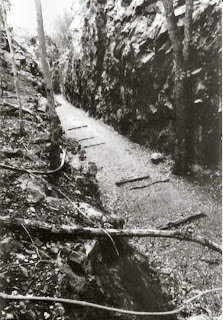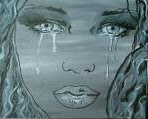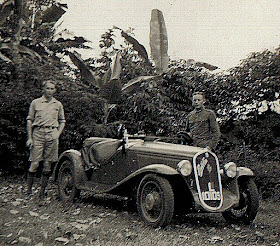In August this year, in The Netherlands, 'channel Nederland 2' send out a documentary which was called 'Archives of tears'.(archief of tranen) I was able to see it on the internet.www.uitzendinggemist.nl (Omroep Max)
August 12 and 19,2012.
With great interest and overwhelmed by emotions I watched the two documentaries.
As a ' war child' ( born June 3,1941) I lived and saw the fear and grief again of my mother. A grief, hidden so deep, a grief she was never able to talk about.But why is it that this grief and loss from 'then', is also in me? Sometimes the tears are streaming down my cheeks, when I think about my mother and think about what burden she carried. I feel guilt that I did not understood her, and I feel guilt that I did not supported her more. But I did not know and did not understand.After her death in 2003 I found a pouch with letters and photographs about 'then', and it was than that I understood. 'But tears do clean your soul?' That's what I believe.My mother was never able to let 'then' go. I carry no hatred in my heart towards Japanese people, and the young nationalists 'the Pemoedas' who were fighting for an independent Indonesia.These young men were well taught, and brainwashed by the Japanese, during the occupation of the Dutch East Indies.
I wished my mother would have lived to see this documentary and know that the Dutch people finally realize how their fellow country men had suffered, in that far away land in The Dutch Indies during World War 2, and after the capitulation of Japan, when the Bersiap began.In the Netherlands the Dutch prevailed to understand the Dutch repatriates who returned to the Netherlands.
After watching the documentary I came to the conclusion that every family from the former Dutch Indies carried their own archive of tears.
When I saw this documentary and saw survivors talking about the horrible past, with tears streaming down their cheeks, that's when I see in my memory my mother Sietske and see her grief again.Why is it that only now all this past is surfacing? Even now the Journal news in the Netherlands hardly ever talks about this period in history,they like to erase it from the collective memory of the Netherlands.Passion about sensation seems for them to be more important and we the Dutch from the former Dutch Indies are no news anymore.We are the forgotten ones.
It was a shame that the Dutch government did not recognized the Independence of Indonesia in 1945 as the year of Liberation. The government recognized the Independence not until 1949.
In the meantime 20.0000 victims were slaughtered under the three colored flag of the Netherlands in this 'Bersiap' period, more or less sold by the government of Holland.
Freedom without Peace!
During the Japanese occupancy the Japanese had fueled these young men into believing to kill everything what had white blood, and that Asia should be for the Asians.Which was of course at the time of the Japanese occupation just a propaganda stunt.
Celebrating freedom from the Japanese, and walking out of the camps, was short lived.Outside these camps was a new danger.Many women, men and children, who had survived the horrors of the Japanese camps were murdered by these young Pemoeda's. Slaughtered and killed with knives and sharp bamboo sticks. Left in the streets as if they were dead leaves fallen from the trees. Many Indonesian friends who tried to bury the dead were taken prison and tortured.People who were taken to Tjideng prison were murdered that same night and their heads decapitated.
The following morning the Pemoeda's were playing soccer, using the heads as soccer balls.
Terrible unbelievable atrocities inflicted the Pemoeda's. One such thing I have to write on my blog, because what I am about to write could have happened easily to my mother and me.We were taken from Banjoebiroe 10 camp at the end of November, 1945. We were loaded into trucks with mattresses all around us, to a safer place.We had been lucky only once in awhile we were shot at, the mattresses protected us from being hit by bullets.Our convoy reached the place of destination without major incidents.Not all convoy's were as lucky as ours.
This person who survived one of the ill fated convoy's writes:
' The truck in front of us became stuck in the mud. The Pemoeda's put a match to this truck and soon the truck was engulfed in flames. A mother on the truck threw her child out of the truck on the road, hoping the child would be safe. To our horror this child was pierced on the end of a bamboo stick and was thrown back in the burning truck. The sounds, the smell, the images, they are always in my head.It was so horrible.
My aunt Elizabeth van Vaas-Thiel (during our imprisoned time, everybody was my aunt or my oma) was in Camp Ambarawa 9, taken there at the beginning of August 1945, while my mother and I were taken to Banjoebiroe 10. The Britisch troops had reached the camps in Ambarawa, except Camp Ambarawa 9. The Indonesian Pemoeda's knew this, and their camp was attacked. All women and children were ordered to come outside in an open field and there they started to shoot and throw hand grenades at them. There were little boys with the Pemoeda's who could hardly hold a sort of machete or gun, she told me,' they were holding it with two hands.
Many women and children were killed that day, my aunt told me she was hiding under a bed and had not gone outside. She will never forget the blood, she told me :'that's all I can see in my mind'.
Sadly she is not with us anymore, but she was at our wedding in 1961.
 | |
| Elizabeth Thiel-van Vaas, 1961 at our wedding. |
There was no help for the women and children who were badly wounded.We were all so scared. The next day they got some help from some Gurkha's from the British Army. The Pemoeda's were shooting daily at the camp. Most of the time 'she told me' we were laying under our mattresses on the ground.Finally they were taken from this camp, but not before the English had cleaned out all the villages along the road their convoy traveled. They finally reached Semarang, where she was taken to a safer camp.
In 1958 I had met my Husband (now married for almost 51 years) and were to be married in October, 1961. When we filled in the papers we found out to my horror that I was not existing. I had no birth certificate, nothing.
My Aunt Elizabeth (I called her Aunt Bep) was one of the persons who had to swear in front of a judge in the city of Haarlem that I was Tetske T. van der Wal, and my mother was Sietske Sijtsma and my father was Klaas van der Wal, who had died on the Burma railroad line.
When we got back in the Netherlands I did not exist, my birth certificates were burned and the Municipality of Bandoeng was burned down to the ground.We had to find three people who had known me in the former Dutch Indies.I was 21 years old at the time and could not believe what we had to go through and how much money this was costing us. The government of Holland just did not believe that I was who I was. How sad was this? My father had died for his country, the Netherlands, and we had to pay for this?? I needed these papers, because I was getting married, and without a birth certificate they would not allow me to get married. How difficult it was to find three people who had survived the camps and the 'Bersiap". Needless to say, we only found two and my mother's sister Eke van Driel-Sijtsma was finally allowed to testify. It took us three months to try to get this in order and a lot of money.The other lady was Marijtje Seijderveld-Postma.She had been in Moentilan Japanese camp with us.
You can take a child from a war, but you will never take back a war from a child.
My mother passed away in a nursing home, where she spend the last two years of her life and suffered hallucinations of being chased by Japanese and Pemoeda's. Even on her death bed she tried to climb up against the wall, she could not talk anymore, but I never forget the look in her eyes when we tried to calm her down.
It is no wonder that this war trauma had left big scars, even on me.
Recently there has been a lot of talk about the 'Rawagedeh',a village in Indonesia, where Dutch soldiers apparently killed all men .The Netherlands will pay compensation to the next of kin.Nine relatives are still alive and the Netherlands will pay each of them 20.000. euro.During the 'Bersiap' period, the villagers were refusing to tell where the Indonesian Independence fighter Lukas Kustario was hiding. Four hundred and thirty one villagers were killed, almost all of them were men.What would you think would have happened to all the villagers if they had told where this murderer Lukas Kustario was hiding? Do you think any of these villagers would have been alive? They would have been slaughtered, all of them, men, women and children by the Pemoeda's, just like they slaughtered twenty thousand Dutch women, men and children , what about them??? This was an incident after the soldiers from the Netherlands were suppose to restore order in the Dutch Indies. These poor boys had just fought a war in Europe against the Germans and were now send to the Dutch Indies.They were made out like criminals, when they returned to the Netherlands.
For the Netherlands it's a blank page in history, and should be forgotten as soon as possible.Never mind how many of these young men never did got home, never mind how many did come home with terrible war trauma's. Don't talk about it and get on with life.
We had a very good friend Jaap Bos who was one of the soldiers send to the former Dutch Indies. My mother and Jaap became very good friends.They were talking for hours with each other.They had a real bond, because my mother understood.He had been in the very same places in Java where my mother and I had been.We left Indonesia April 1946 about the time that he was send there to restore order.Coming home was awful he told my mother,it was very sad.He was a very good guitar player and we always had lots of fun with him.
 |
| Jaap on the left at our house in Zandvoort, 1958. |
Or is the government waiting till we are all dead and gone?
It is a shame that the focus has been for so long on West Europe and what happened in that period, and everything what happened in the former Dutch Indies has long be "forgotten".
Understandable the Indonesian people try to forget about this black period the 'Bersiap', with saying that this time was a time of utterly 'confusion'.
Remarkable is that the Dutch and the government, show more interest about the misdoings of the Dutch military in 1945-1949, than for the crimes the Indonesian Pemoeda's inflicted on their Dutch Civilians during the 'Bersiap' period.
This documentary could not have come at a better time,just now some special groupings make it their life engagement to force the government of Holland to give Indonesia an apology for what their military have done. I am sure that some of the military have done things which should not have happened. But I can sympathize with them if they have seen what the Pemoeda's have done to babies, young children and women and men.What the survivors are telling what happened to their families,is not to describe.One family with six children were slaughtered with knifes and sharp bamboo sticks and the oldest girl only 13 years old was first raped and the spear of a bamboo stick put in her vaginal.The mother unbelievable survived.She heard the screaming but was not able to do anything. She was in and out of consciousness.When she tried to get up they hit her again and was thrown off a cliff. It's almost too terrible to write down, but the documentary tells all.I cannot believe I just wrote this down,I am about to throw up....it sickens my stomach........But my question is don't they deserve justification??This woman survived and arrived in the Netherlands, all alone, her whole family murdered in front of her eyes, her husband and her six children. She lived the rest of her life in The Hague, with all these horrible memories, and not feeling at home in the Netherlands. Her home had been in Indonesia with her husband and her children, a very happy home.First she had to suffer under the Japanese regime and than thinking it is all over we can start our lives again, it was taken away from her and from so many more people. Why do always innocent people suffer.
The documentary is in Dutch and I hope it will come out in English. People have to know the other side as well.Probably this group of people who are fighting for justification for Indonesia should educate themselves and ask for an apology from Indonesia as well for what the Pemoeda's have done to their own people. What happened during the Bersiap-period in which Dutch Indies families were slaughtered by these Indonesian Pemoeda's, was pure hell.Yes there are and were survivors too.
Reparation and Honor for this group is not too much to ask for. Pay the outstanding wages (with interest) give them compensation,they lost everything, at least the women from that village could stay in their own houses, yes they lost their loved ones, killed by the soldiers, we lost our loved ones,slaughtered by the Pemoeda's, we lost our houses and our country we loved so much.A line should be drawn under these arguments of the past- in the context of time- glorious past.
The Dutch are on purpose kept in the 'dark' about what happened in Indonesia during the years after the war.
The remark from Mr. Bot about " wrong side of the history" shows obviously the condition of "stupidity" in which we find oneself.
The Japanese said:"We lost the war, but you will forever be haunted up to the fourth generation!" Sadly it is the truth.
It was time that this side of the story has been told.The documentary 'Archive of tears' finally shed recognition and your 'archive' makes this story complete and is maybe the start that this chapter of the book the 'Netherlands and Indonesia' , can close in the right manner.
And may be one day Japan will follow suit.
Thank you Pia v.d. Molen
 | |
| Rays of Hope! |







+of+cardf1.jpg)



























+of+DSC01912.JPG)
.jpg)















